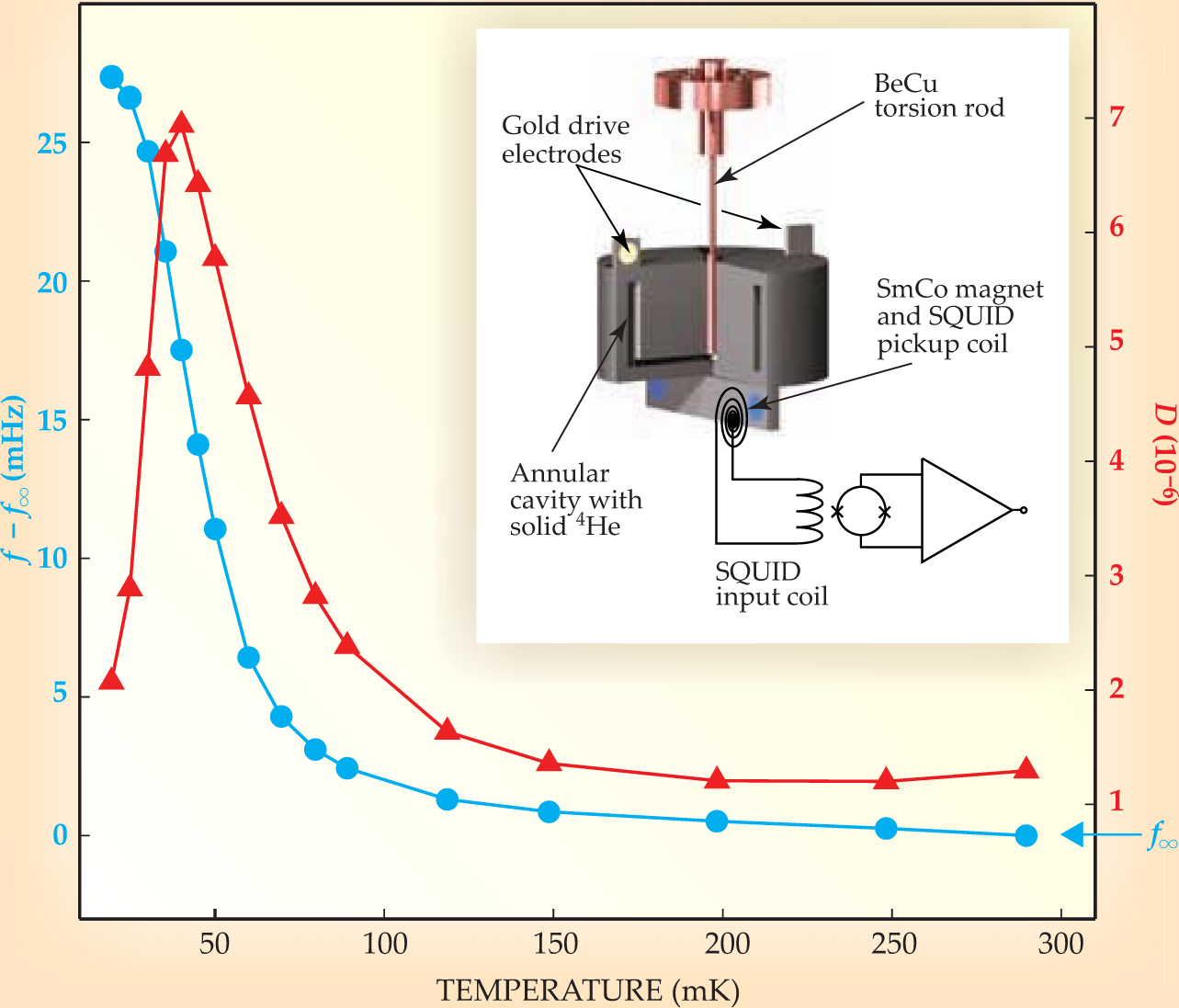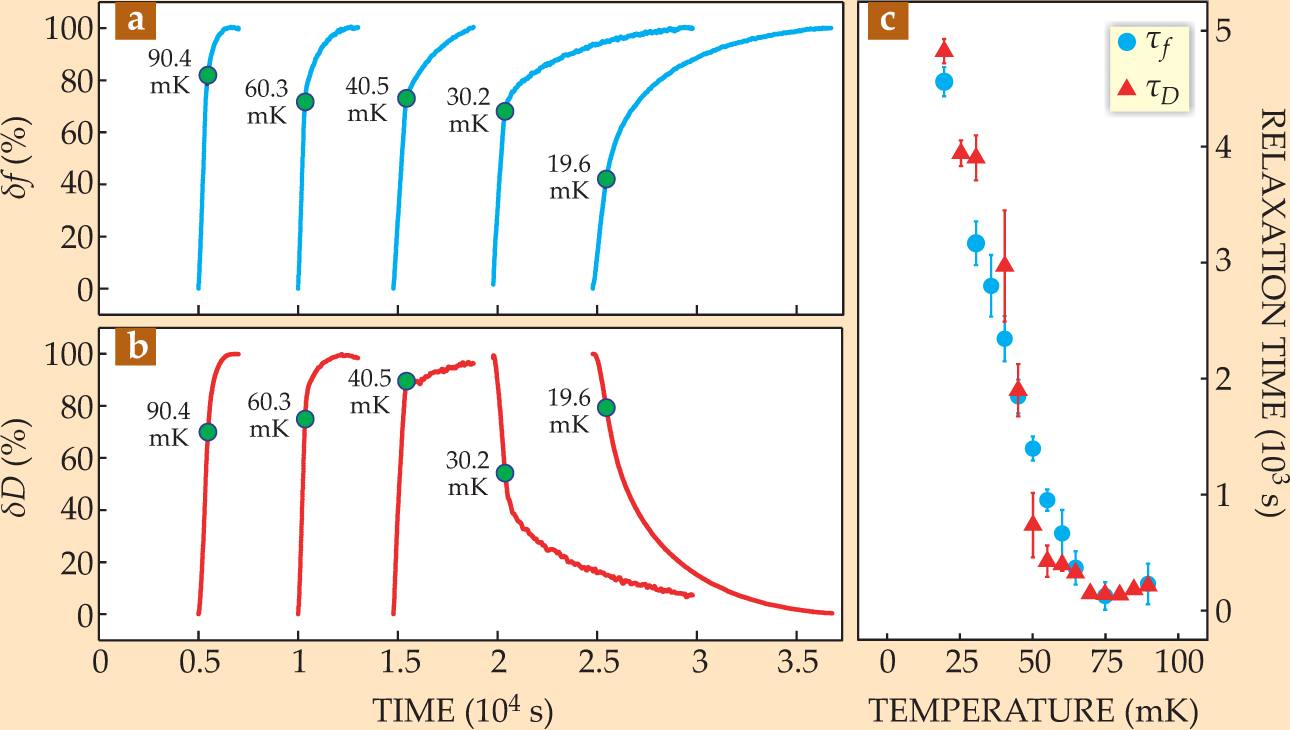Superconducting device helps probe glasslike dynamics in solid helium
DOI: 10.1063/1.3177216
In 2004 Moses Chan and Eun-Seong Kim found evidence of a new state of matter in helium: a solid that flows without friction, like a superfluid.
1
When they filled a torsion oscillator with solid He and cooled it below 200 mK, the oscillator’s resonant frequency increased. Some small fraction of the He’s mass appeared to have decoupled from the rest, so that it was no longer contributing to the total moment of inertia. (See Physics Today, April 2004, page 21
Now, Cornell University’s Séamus Davis and colleagues have developed a new torsion oscillator, with a far more sensitive position sensor based on a superconducting quantum interference device (SQUID), with which they can greatly expand the amount of available data. 2 Their results show that some very slowly evolving degrees of freedom govern He’s behavior at low temperature, suggestive of a glasslike phase.
Theoretical possibilities
Conventional supersolidity theory has been around for decades. It predicts that superfluid flow could result from the condensation of a solid’s lattice vacancies into a single quantum state. Even if that phenomenon occurs in solid He, it’s not the whole story, because the theory fails to explain some of the observations that experimentalists have made over the past five years. For example, the dissipation D—the reciprocal of the oscillator’s Q factor and related to the damping strength—exhibits a peak as a function of temperature that the theory doesn’t predict. Matter that is flowing without friction shouldn’t be able to damp the torsion oscillator’s motion.
In 2007 Alexander Balatsky of Los Alamos National Laboratory and colleagues presented an entirely different explanation for the increase in the resonant frequency and the peak in the dissipation.
3
They proposed that the He’s behavior was due not to the onset of supersolidity but instead to a glass transition in which a liquidlike system of mobile lattice defects condenses into a glassy rigid network. (For more on dislocations in solid He and their possible relationship to supersolidity, see Physics Today, February 2008, page 14
A new twist
Typically, when researchers use torsion oscillators to study solid He, they monitor the twisting motion via the changing capacitance between two electrodes, one mounted on the torsion bob and the other kept stationary. But capacitive sensors are limited in their sensitivity and in the range of oscillation amplitudes they can track. Oscillations cannot be so large in amplitude that they bring the electrodes into contact. And the sensitivity to small amplitudes or changes in amplitude is compromised by small shifts in the electrodes’ positions during cooling to cryogenic temperatures.
In the Cornell team’s SQUID-based sensor, a permanent magnet is affixed to the torsion bob, as shown in the inset of figure 1. As the oscillator twists, the magnet moves, and the changing magnetic field is detected by stationary coils. It took three years of dedicated effort by three students and one post-doc to get the device to work—isolating the system from vibrations was among the biggest challenges. But once the apparatus was up and running, it overcame the limitations of the capacitor-based sensor to a large extent; it allowed the magnet’s position to be measured with femtometer sensitivity and a 10 000-fold improvement in signal-to-noise ratio.

Figure 1. When a torsion oscillator filled with solid helium is cooled, the oscillator’s resonant frequency f increases monotonically with respect to its asymptotic value f ∞ while the dissipation D (related to the damping strength) exhibits a peak. The inset shows the torsion oscillator, with a SQUID as its position sensor, that was used to collect the data.
(Adapted from

Better sensitivity to small changes in position is useful for measuring D, which is derived from the amplitude of the oscillation that results from a particular driving force. The ability to explore a wider range of amplitudes is also important because the apparent supersolid fraction—the portion of the He’s mass that appears to flow—depends on the peak velocity of the torsion oscillation. And the improved signal to noise has allowed Davis and colleagues to automate the system to collect large amounts of data quickly. Since the physical origin of the He’s behavior is not clear, it’s also not clear what experiment will prove key to understanding it. As Davis explains, “When you don’t know what you’re looking for, you have to measure everything.”
Take it slow
Figure 1 shows the Cornell team’s measurements of the temperature dependence of f and D, which are consistent with previous results. Among their new results, shown in figure 2, is a study of how the frequency and dissipation evolve in response to a sharp decrease in temperature. First, both quantities change rapidly as the system approaches its target temperature. When that temperature is reached—as indicated by the green dots in figure 2—the rates of change of both quantities abruptly decrease. But the rates don’t decrease to zero: The frequency and dissipation continue to relax toward their equilibrium values with time constants that are nearly the same for both quantities, which suggests that the physical origins of the changes in f and D are closely linked. The time constants increase steeply with decreasing temperature, much like the flow time of cooling molten window glass.

Figure 2. Time-dependent responses of (a) the resonant frequency f and (b) the dissipation D to stepwise decreases in temperature. After the target temperature is reached (green dots), both quantities continue to move toward their new equilibrium values with characteristic relaxation time constants. (c) Temperature dependence of the relaxation time constants τf and τD obtained by fitting the curves in panels a and b to exponential functions. The trajectories of τf and τD are similar and increase steeply at low temperatures.
(Adapted from

Although Davis and colleagues were not the first to notice the slow time response of solid He at low temperatures, the synchronized ultraslow dynamics in f and D were unanticipated by many researchers, and plenty of puzzles still remain. “The results can be interpreted in terms of some sort of glassy behavior that must be closely linked to the apparent supersolidity in a way that is not understood,” explains John Beamish of the University of Alberta. “The mechanical response of a torsion oscillator, particularly the relationship between the dissipation and the period shift that suggests supersolidity, is one of the major open questions, and this paper is a significant contribution to understanding it.”
References
1. E. Kim M. H.W. Chan, Nature 427, 225 (2004); https://doi.org/10.1038/nature02220
Science 305, 1941 (2004). https://doi.org/10.1126/science.11015012. B. Hunt et al., Science 324, 632 (2009). https://doi.org/10.1126/science.1169512
3. Z. Nussinov et al., Phys. Rev. B 76, 014530 (2007). https://doi.org/10.1103/PhysRevB.76.014530
